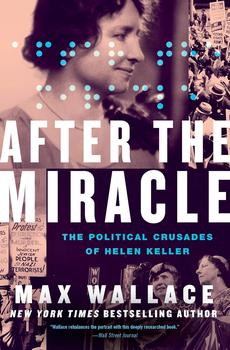Summary | Excerpt | Reviews | Beyond the Book | Readalikes | Genres & Themes | Author Bio

The Political Crusades of Helen Keller
by Max Wallace
Still lacking a building, the fledgling school commenced operations in July 1832 with an inaugural class of six pupils, ranging in age from six to twenty-one, in the sitting room of his father's house. He had recruited some of the students off street corners, others through appeals to the politicians of neighboring towns. Inspired by the methods of Valentin Haüy's work in France, he eventually staged a public demonstration at Boston's Masonic Hall to showcase his students' newly acquired skills. The children would sing hymns, read Scripture, and recite poetry while spectators marveled at their abilities, often in tears. After a newspaper described the exhibition as "one of the most delightful and gratifying spectacles we ever beheld," society ladies throughout New England began competing with each other to stage fairs and exhibitions to raise funds for Howe's much-talked-about endeavor. Before long, he was parading his students before the Massachusetts legislature, which dutifully appropriated the sum of $6,000 per year to cover the tuition of twenty students. In 1833, a trustee named Thomas Perkins donated his home and estate on the outskirts of Boston to establish a permanent facility, which would be known as the Perkins School for the Blind.
Despite its rapid success, Howe was soon bored with the mundane administrative tasks involved in running a school. Complaining to a friend that he was finding the job too "narrow," he confessed that he was craving new challenges. "If I am good for anything, it is as a pioneer in a rough untrodden path. I want the stimulus of difficulty." He soon found just the challenge.
More than a decade before Perkins came into existence, America's first school for deaf children had been established in Hartford, Connecticut, in 1817 by a Frenchman named Laurent Clerc. Similar to the early attitudes about the education of blind people, early advocates argued that teaching deaf children to read would help guide them to Christianity. By the 1830s, thousands benefited from the efforts of Howe and Clerc, both of whom succeeded in bringing the education of people with disabilities into the mainstream. Yet there was another category of disability—a condition little known by most Americans, but one that had captured the imagination of Howe, whose mission was to demonstrate society's obligation to educate all its citizens, regardless of their circumstances. If he was seeking a grand social experiment to prove his hypothesis, there would be no better example, he believed, than the challenge of educating someone who was both deaf and blind.
In future years, Howe was fond of quoting a passage from Blackstone Commentaries, an eighteenth-century British treatise that helped shape the early US legal system:
A man is not an idiot, if he hath any glimmering of reason, for that he can tell his parents, his age, or the like matters. But a man who is born deaf, dumb, and blind, is looked upon by the law as in the same state with an idiot; he being supposed incapable of understanding, as wanting those senses which furnish the human mind with ideas.
In fact, it was generally believed that someone who was blind and deaf— as well as "dumb," the commonly used expression for a person unable to speak—could not possibly possess the capacity for learning and understanding that had already been demonstrated by those restricted by the individual conditions. On a visit to the Asylum for the Deaf and Dumb in Hartford some years earlier, Howe met a resident named Julia Brace, who had already achieved a degree of fame as the only widely known deafblind person in America. Julia had contracted typhus at the age of four and lost both her sight and hearing. Arriving at the Hartford school as the only blind resident in 1825, shortly before her eighteenth birthday, Julia's education had been limited. She knew some rudimentary signs and learned to sew and knit, but there had been no attempt to formally educate her. During her time at the Asylum, she had reportedly shown little aptitude for learning to read or write. In 1831, the famed French philosopher Alexis de Tocqueville visited the Hartford school and wrote about his observations after Julia was pointed out to him. "From time to time she smiled at her thoughts," he observed. "It was a strange sight. How could anything funny or pleasant take place in a soul so walled in, what form does it take? The director told me she was very gentle and easy to handle." Julia also captured the attention of Lydia Huntley Sigourney, one of America's best-known poets, who had championed her story in verse and in a popular children's anthology. These lyrical accounts had gained Julia a measure of celebrity and eventually inspired Howe to pay a visit to Hartford to meet her for himself. However, he concluded that at twenty-seven years old, her advanced age made her an unfit prospect for his goal of proving that a deafblind person could be educated. His search resumed in earnest until the spring of 1837, when he read a report about the case of a seven-year-old child in a neighboring state.
Excerpted from After the Miracle by Max Wallace. Copyright © 2023 by Max Wallace. Reprinted with permission of Grand Central Publishing. All rights reserved.
Your guide toexceptional books
BookBrowse seeks out and recommends the best in contemporary fiction and nonfiction—books that not only engage and entertain but also deepen our understanding of ourselves and the world around us.